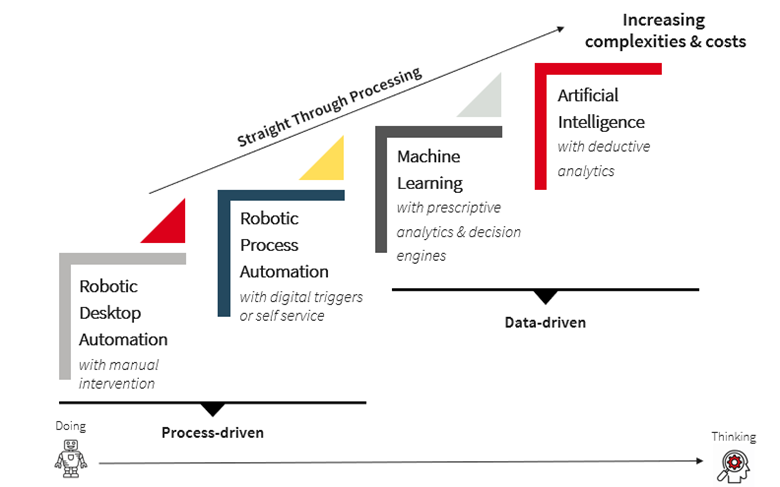by Prerna Bhardwaj
Robotic Process Automation (RPA) can transform long-established inefficiencies in healthcare into cost savings, operational gains, patient satisfaction, and regulatory compliance. So, why haven’t more healthcare organizations adopted this technology?
What is RPA?
At it’s most basic level, RPA takes manual, repetitive tasks and performs these functions through the use of software (e.g. bots, or “digital workers”). Using rule-based logic, bots mimic human actions via the screen user interface, recreating the steps a person would take to complete a task without requiring deep systems integration or custom software. This translates into bots being a cost-effective way to capture and manipulate data, interact with other digital applications, trigger responses, and process transactions, saving on staffing overhead, reducing backlogs, and focusing human intervention on exceptions based processing.
Most frequently used in healthcare in areas of scheduling, registration, and billing/back-office functions, bots can operate 24/7 with no human error, greatly reducing the burden on staff to process patient verification and eligibility requests, appointment scheduling, and claims processing.
| Case Study – Claims Status Bot |
|
One organization developed a claim status bot to reduce the amount of time follow up staff spent researching different accounts, often with little to no impact on the bottom line. By using a bot to process low-level, repeat accounts, staff was able to prioritize their energy on high dollar, valuable accounts based on status. The organization saw a savings of roughly 750K/year. |
However, typical use cases for bots in healthcare expand well beyond patient access, revenue cycle, and finance; bots are also successfully deployed in audit functions, routine IT maintenance tasks, human resources workflows, and healthcare cycle improvements.
| Use Case | Value Prop |
|---|---|
| Scheduling & Registration | • Patient Satisfaction • Streamlined process & increased accuracy • Increased security & compliance |
| Billing & Claims | • Increased efficiency & accuracy • Reduction in payment delays & denials • Increased compliance |
| Patient Experience | • Faster service and/or flexible self-service options • Increased communication, patient involvement, & adherence (automated reminders) • Higher quality of care |
| Healthcare Cycle Improvement | • Record and track larger volumes of data • Leverage advanced analytics to gain insights to: • Centralized & streamline workflows • Deliver patient insights & improve quality of care |
| Compliance/Audit | • Record data and generate reports for audits • Efficiently monitor reports on an ongoing basis for noncompliance |
Combining RPA with other cognitive technologies, such as machine learning, speech recognition, and natural language processing, results in intelligent automation (IA) and a path to artificial intelligence, in which human judgments and context are incorporated so that the bot can perform more complex tasks and evaluate multiple paths of resolution before requiring human intervention.
As an organization moves along the automation maturity curve, machine learning and use of artificial intelligence creates exciting opportunities to innovate across the healthcare continuum.

So, why then, are bots not being used more widely?
On the surface, bot implementations may seem like an easy solution, and, while the coding component of implementing a bot can be as little as weeks, the supporting governance, change management, and communication structures that need to be in place for a successful implementation are often months long endeavors.
1. Establishing a Vision
Every organization has unique principles, values, and culture that should be considered when employing automated solutions to minimize risk associated with introducing disruptive technology to established processes. It’s imperative for an organization’s leadership team to define their mission and objectives, whether they be financial, regulatory, operational, or otherwise, prior to beginning an RPA implementation in order to align stakeholders across business units. Collaboration and commitment across the organization is crucial, as the scope of RPA does not solely reside in the IT department, but across all impacted users.
2. Design & Planning
A strong leadership team with defined roles and responsibilities should be selected to facilitate feasibility analyses on use cases, identify potential software partners and technical requirements, define a target operating model, user access and security controls, and establish an organizational structure for RPA governance (e.g. Center of Excellence). One of the major pitfalls of RPA occurs in the initial planning and design phase, where the use cases selected are not fully considered in the context of their end to end processes or technical requirements are not fully vetted. A proof of concept environment and feasibility analysis with all impacted stakeholder groups greatly mitigates the risk of using RPA where it’s not a suitable solution.
| Case Study – How Mayo Clinic pivoted an unsuccessful RPA implementation into a success |
|
“Initially, Watson CTM was launched as a point-of-care solution for oncologists. Despite efficiently matching patients to trials, low provider adoption occurred due to multiple factors especially time constraints. The project team engaged Mayo Clinic management engineers/business consultants to assess, reengineer and integrate the process and workflow. Clinical Research Coordinators (CRCs) took on the role of screening patients with CTM. They generated a list of matching trials for each patient and provided them to the patient’s oncologist. The new process significantly increased trial enrollment and CRCs workload for patients on study. The project team determined that the process needed to be further transformed by creating a dedicated trial matching team to balance workload and create a seamless experience.” https://insights.btoes.com/2020-award-finalist-spotlight-mayo-clinic-finalist-in-the-technology-enabled-process-automation-0-0 |
3. Change Management
While outsourcing to workers abroad has become common practice, the idea of outsourcing work to a bot, or “digital worker,” requires thoughtful messaging and planning. The human element of RPA implementation cannot be understated as people and culture play an enormous role in whether RPA can be successfully deployed and adopted. This translates into identifying workers whose jobs will be impacted by this change, including whether they will need retraining in their current role, what capacity creation is fostered to enable them to focus on different tasks, and what training they may need to handle exception processing for tasks bots are unable to execute.
A second component to this is managing the expectations of end users or requestors, and anticipating their experience in interacting with bots. Communications should be sent out in advance of a bot implementation to notify users of the upcoming change, process documentation should be updated, and instructions and training should be distributed (where applicable) leading up to bot deployment.
| Case Study – End User Adoption of Self – Service Password Resets |
|
Outside of providing training, lunch and learns, and sending out communications, one organization hastened end user adoption of self- service functionality to reset passwords by removing the ability of the help desk to assist with this process. To further increase adoption, they leveraged chat bots and an IVR solution to allow end users to choose which method they preferred. This “as you like it” approach gave users a sense of flexibility and helped mitigate resistance to this change. |
4. Governance
Bots require ongoing maintenance and upkeep; without considering the entire bot lifecycle, they can quickly become outdated or ineffective, especially as changes are made to other systems and processes they interact with (e.g. security patches, updates, password changes). Command and control over bots is arguably the biggest linchpin to success and can be supported in the following ways:
a. Establish a Center of Excellence staffed with people who actively measure bot performance and monitor expected outputs. This staff should also participate in feasibility analyses of proposed use cases, in defining expected ROI prior to bot implementation, and measuring against these outcomes for cases that are greenlit.
b. Leverage governance dashboards to monitor bot outputs and highlight areas of opportunity to maximize efficiency. Dashboards should also flag when bot output is disrupted or underperforming for further investigation.
c. Integrate RPA into the whole development lifecycle and ensure RPA technology in use is considered prior to major changes being made to other applications. RPA technology should be considered in the same terms as interfaces and systems integration are considered when moving forward with other technology changes.
By creating a governance structure that secures commitment and confirms collaboration across stakeholders, considers bots as an integral part to the technology stack, and assesses their role in end to end processes, automation becomes a key component in the digital journey. Organizations are then able to achieve process change and create behaviors that enable long term organizational aims through an automation framework.
Conclusion
In 2020, we’ve seen healthcare organizations make great strides in automation when faced with the challenges of managing increased demand from their patient populations during the course of the Covid-19 pandemic. With the increasing unpredictability and complexity of real world scenarios, and consumer demand for flexibility and efficiency, leveraging automation in predictable scenarios to support existing processes will become crucial in managing demand without increasing costs and comprising security.


